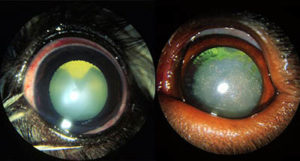ARTICLES
DIABETES AND THE CANINE EYE
Published Monday, January 20, 2015

In humans, diabetes is associated with various changes within the eye, the most concerning of which is proliferative diabetic retinopathy – a blinding disease of the blood vessels within the retina. In our canine patients there are several recognized ocular diseases associated with diabetes as well:
- Diabetic cataracts: This is the most common and important manifestation of diabetes in dogs. As the levels of sugar rises in the blood, the sugar within the aqueous humor is also increased. To make a long story short, the canine lens does not like this and often rapid onset, blinding cataracts with inflammation are the result.
- Poor tear film quality and quantity – otherwise known as keratoconjunctivitis SICCA
- Retinal saccular aneurysms and hemorrhages of little clinical significance
Diabetes mellitus (DM) is often diagnosed at various stages in our canine population. When the diabetes is severe and poorly regulated, the cataract development and blindness seems to progress quickly. When DM is caught early and treated with good response, cataract development can be delayed . The better the response to insulin and better blood sugar regulation often results in better visual outcome. Most dogs (75%) develop cataracts within 12 months of the diagnosis of DM. Fortunately cats do not seem to be prone to diabetic cataracts at all!
As diabetic cataracts progress, it is important to know that they often cause inflammation within the eye – known as “lens induced uveitis”. This inflammation is often the cause for other related complications such as the development of glaucoma or retinal detachments. When diabetes is diagnosed, close monitoring for the development of cataracts is advised. When cataract development is beginning, topical NSAID anti-inflammatory therapy should be initiated to mitigate the effects of uveitis and decrease further risks for the eye. It also makes the patient a more suitable surgical candidate.
Cataract surgery is the only available therapy able to restore sight in dogs blinded with cataracts. There have been claims of miracle drops stopping or reversing cataracts, but these claims are unsubstantiated, unregulated by the FDA and purely anecdotal. Microincision phacofragmentation of the lens using ultrasonic energy is the state of the art. Implantation of acrylic replacement lenses that fit through a < 3mm incision is standard, even in our veterinary patients, by those trained in this technique (such as Dr. Greller and Wagner). The goal of surgery is always to restore vision and promote better quality of life. Not all patients are suitable candidates and a pre-surgical work-up is advised including blood and urine testing, retinal testing (ERG or electroretinography), and ocular ultrasound to check for retinal tears or early detachments that may need to be managed for best outcome.
Diabetic-associated poor tear film quality and quantity is often addressed medically with topical therapy. Many over the counter tear replacement therapies are available, the proper choice dictated often by the particular layers of the tear film that need modification or supplementation.
Luckily, most dogs do not have significant effects of diabetes on the retinal health as in people. The small hemorrhages that we often see occur years after cataract development and wax and wane typically without obvious change in vision. There is no surgical therapy that seems to be effective for this situation.
If your dog has diabetes, please see to it that your veterinarian performs an ophthalmic examination after pupil dilation. If cataracts are present, they will progress. Surgical therapy early in the course of the progression is more advisable over waiting until the cataracts are “ripe”. The cost of surgery is typically around $1,800-2,000 per eye.
 Located in the SAVS Facility
Located in the SAVS Facility
